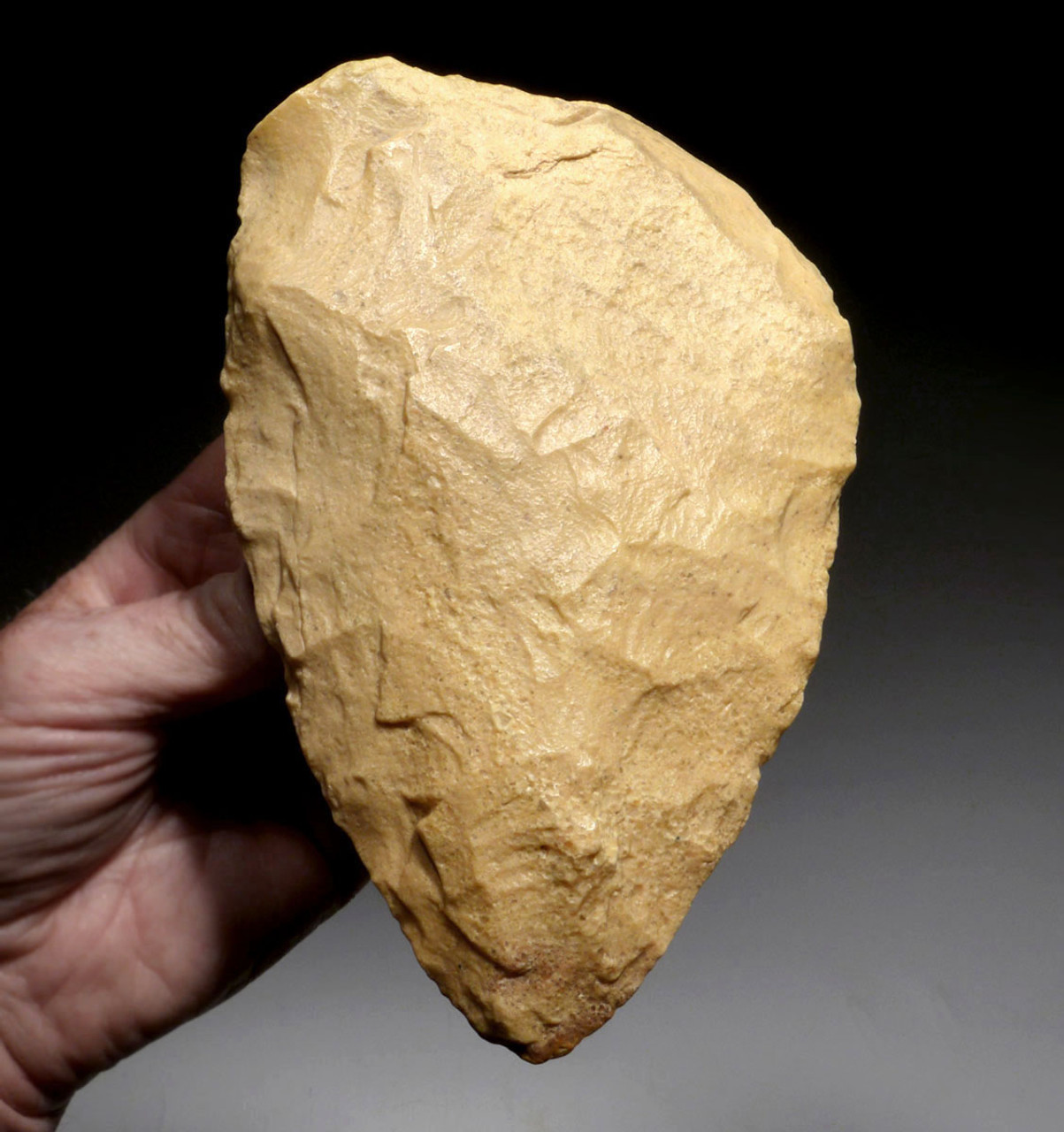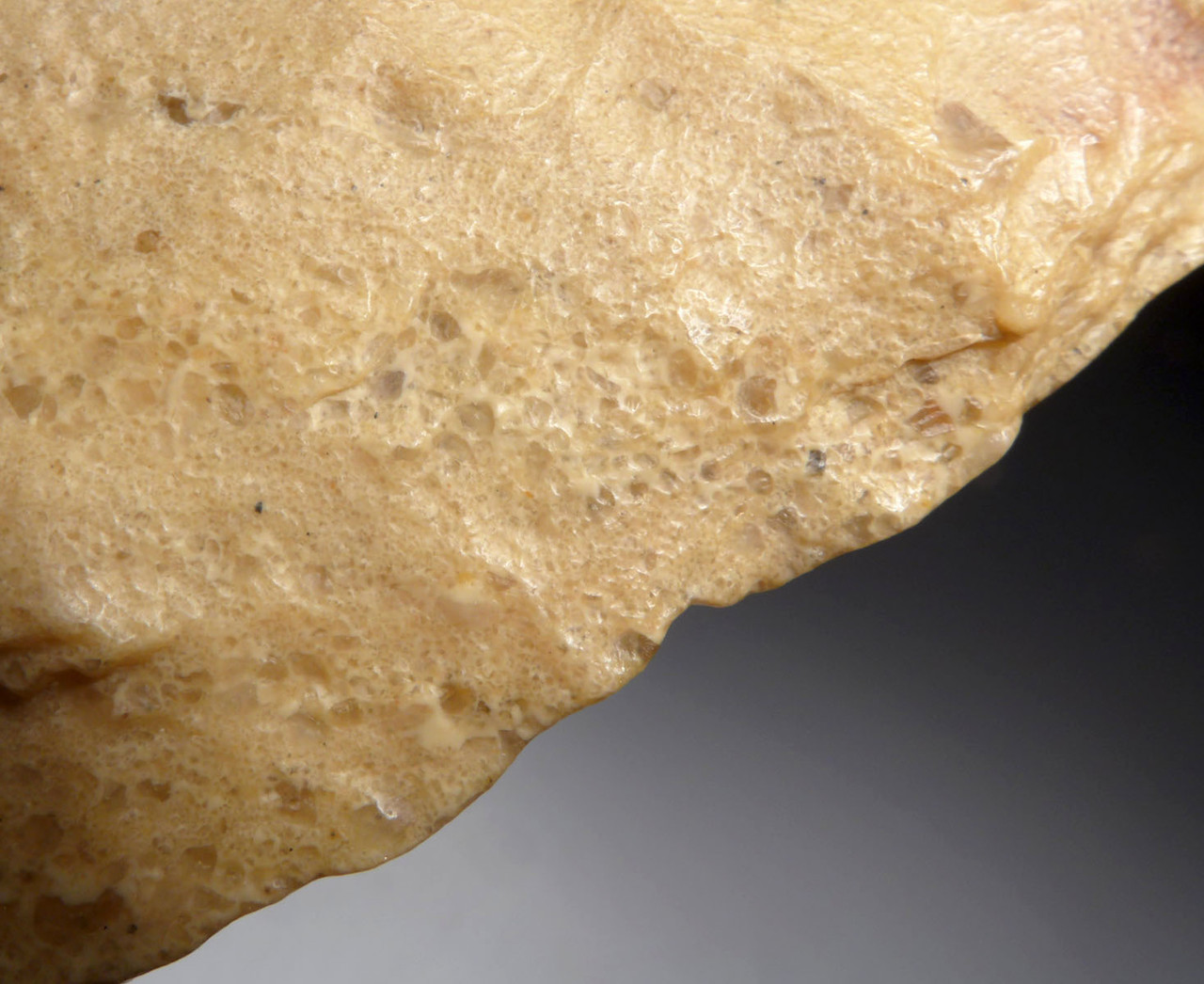Product Description
For comparison prices, please see the "Old World Typology and Price Guide" section of the "OVERSTREET IDENTIFICATION AND PRICE GUIDE TO INDIAN ARROWHEADS" editions 7th, 8th and 9th.
SEE MORE LOWER PALEOLITHIC ACHEULEAN STONE ARTIFACTS
This INCREDIBLE Acheulean hand axe was made and used by early humans of the primitive species Homo erectus (ergaster). It was surface-collected from an exposed Lower Paleolithic Acheulian site in the South Central Sahara Desert of Central Africa. Acheulean Lower Paleolithic hand axes from Africa represent the first scientifically documented intelligent tool made by primitive humans. Prior to these Saharan Acheulean handaxes, only crude pebble and flake tools existed in the human fossil record.
We've handled many hundreds of museum-class, exceptional African Stone Age hand axes but RARELY have we encountered one as impressive and unique as this. For the first time, we present an African Acheulean hand axe made of golden puddingstone conglomerate. The perfect and unusually large amygdaloid bifacial form, combined with the extreme thinness of the entire body, is only further enhanced by the incredibly beautiful golden, glossy glow of the stone with its unique inclusions. Without a doubt, this is truly an example of some of the earliest artistic expression in primitive humans. Not only was the stone used a type that is rarely encountered in prehistoric African artifacts (our first time we have seen it!), but the degree of flaking and workmanship is of the most refined level one could achieve. Millennia of desert wind exposure has further polished the surface highlighting a level of stone knapping that very few could have achieved, past or present! The very slightly offset proximal end even incorporates a region of natural stone surface that falls where the thumb lays when held. This shows that not only was its primitive human maker a highly capable master artisan, they were also highly intelligent to use a slightly natural rough surface to aid in keeping the hand from slipping when held. If you were to exhibit the finest and most classic form of a Lower Paleolithic hand axe, this would be the example to show. It is impossible to improve upon!
This is an irrefutable prestige tool and RARE prehistoric sculptural masterpiece of Homo ergaster (African Homo erectus). It was made with an aesthetic we have never seen and the level of flaking workmanship far surpasses what would have been needed in an ordinary utilitarian use. The almond-shaped form shows a beautifully pointed tip that has a portion of red in the stone, purposely oriented to fall on the tip when this hand axe was first shaped. This hand axe demonstrates prehistoric human ARTISTIC EXPRESSION and PRESTIGE APPRECIATION, as well as the skill and ability of Early Man's ability to work stone to the highest order. It features every possible aspect of a prize specimen unlike ANYTHING we have ever seen in many decades of experience. Many theorize that these hand axes were the earliest form of art, flaked by master toolmakers to a degree that conveys prestige, status and achievement. Seeing this specimen certainly supports that claim.
Original sediment and mineral encrustations are still present in microscopic crevices and on some surfaces - a trait ONLY found in authentic Paleolithic artifacts like these. These features are a testament to the age and authenticity of ALL Saharan Paleolithic artifacts.
Genuine Saharan Acheulean hand axes of this quality are rare and recent realized prices at major auction houses are proving what we have been saying for year, that authentic high grade artifacts of primitive humans remain one of the most promising investments. Specimens like this are one in many, many thousands and are exceptionally rare. Collectors consider prized features to include either size, workmanship or color but when ALL exist, then it is truly an important piece to include in a collection as this one is.
HISTORY
During this time in prehistory when this Lower Paleolithic tool was made, the Sahara Desert (where this stone tool was found) was a savanna rich in wildlife. Prior to the prehistoric global warming that turned the vast region to desert, early humans lived alongside prehistoric giraffe, bison and elephant, which were vital to their survival. Hunting and butchering these animals would have required specialized tools such as those found in the Acheulian Period.
 US DOLLAR
US DOLLAR
 EURO
EURO
 AUSTRALIAN DOLLAR
AUSTRALIAN DOLLAR
 CANADIAN DOLLAR
CANADIAN DOLLAR
 POUND STERLING
POUND STERLING






























